Pratt & Whitney Twin Wasp Junior (R-1535)
Compiled by Kimble D. McCutcheon
Published 20 Apr 2020
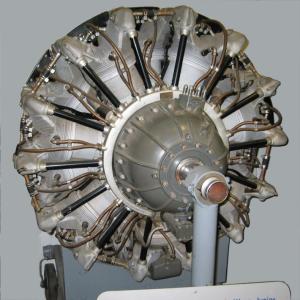
Pratt & Whitney R-1535-96
(Kimble D. McCutcheon) |
The Pratt & Whitney Twin Wasp Junior was a 14-cylinder two-row radial using the same cylinder size as the Wasp Junior. It first ran on 17 Oct 1931 and the first production engine was delivered to the U.S. Navy on 14 Mar 1932.
With a takeoff rating that, depending on model, ranged from 650 to 825 hp, and a relatively small diameter for its output, the Twin Wasp Junior was an attractive candidate for many aircraft designs. Racing applications included the Bellanca 28-70 and the Hughes H-1. Several operational Navy biplane fighters by Boeing, Curtiss, Great Lakes and Grumman used the engine, as did many prototype biplanes. The Twin Wasp Junior also powered Navy monoplanes, including the Northrop BT, its later variants, and the Vought SB2U. Army monoplanes using the engine included the Northrop A-17 and Douglas O-46.
Pratt & Whitney and its licensees produced 2,880 Twin Wasp Juniors between 1932 and 1941. |
Twin Wasp Junior Description
Type = 14-Cylinder Two-Row Air-Cooled Radial
Bore = 5.188" Stroke = 5.188" Displacement = 1,534.9 in³
Cylinders are of a steel and aluminum construction. The cylinder barrels are machined from steel forgings and have integral cooling fins. The head with its integral rocker boxes and cooling fins is an aluminum alloy casting. The cylinder barrel is screwed and shrunk into the aluminum head, forming a permanent joint. Each cylinder has one inlet and one exhaust valve. The inlet valve seats on bronze inserts and the exhaust valve seats on steel inserts, with both insert types shrunk into the head casting. Cylinder baffles that route air to all finned surfaces are standard.
All valve operating parts are enclosed. The rocker arms are supported by ball bearings in the rockers. The tappets actuate the rocker arms through tubular push rods, which have hardened steel ball ends. These rods are enclosed by round removable oil tight cover tubes held in place by a nut and packing at the top and bottom. The upper packing nut fits on to a gland screwed into the cylinder head push rod seat, and the lower packing nut screws on to threads in the tappet guide. Two concentric valve springs are secured to the valve stem by a split cone and washer. A valve clearance adjusting screw on the rocker arm valve end has a hemispherical tip to minimize friction and side loads. Valves and valve mechanism are automatically lubricated with engine oil. Two dual-track cams with external teeth operate the valves. One cam, mounted at the crankcase front, operates front-bank valves. The other cam, at the crankcase rear, operates rear-bank valves. Each cam runs on a bronze bushing bolted to the crankcase.
The engine consists of a nose section, main (power) section, blower section and accessory section.
The nose section on geared engines houses the propeller reduction gear assembly and contains variable pitch propeller control accommodations. A deep-groove ball bearing transmits the propeller thrust to the engine. Planetary reduction gearing consists of an internally-toothed bell gear (driving gear) that is splined to the crankshaft front and supported by a roller bearing mounted in an anchor plate secured between the nose and main crankcase sections. A fixed gear is bolted to the nose section front . Six pinions on the 3:2 gearing (5 pinions on the 4:3 gearing),mesh with the bell gear and fixed gear and are mounted in a cage that is splined to the propeller shaft. Each pinion, mounted on steel backed bronze bearings, rotates around a special inner race on a concentric shaft. The propeller shaft fore end is supported by a deep groove ball bearing in the nose section and at the rear end in a bronze-lined bearing located inside the crankshaft.
The main section is composed of aluminum alloy front, center and rear crankcase segments, which are held together by bolts and machined as a unit. The cams and cam bearings are supported on integral shelves on the front and rear crankcase segments. Tappets and tappet guides are housed in the front and rear crankcase segments.
The two-throw one-piece crankshaft is supported on roller bearings mounted in the front and rear crankcase segments, and a ball bearing mounted in the center crankcase segment. The crankshaft front is supported by a deep-groove ball thrust bearing in direct-drive engines, while geared engines employ a roller bearing mounted in an anchor plate between the nose and main sections. Counterweights attached to the front and rear crank cheeks balance the reciprocating and rotating masses. A Salomon tuned vibration absorber in the rear counterweight of some engines addresses torsional vibration.
The master rod has a detachable big end cap that captures a bronze lined bearing. Twelve "I" section link rods are attached to the master rods with knuckle pins. Each rod is bronze bushed for the piston and knuckle pins. Oil is carried under pressure to the master rod bearing, and also to the knuckle pins. The piston pin bushings are lubricated by a mist or spray of oil from the master rod bearing.
The blower section, attached to the crankcase rear, mounts the engine to the airplane. A supercharger is also housed in the blower section, along with its 8.7:1 drive gearing, diffuser and induction passages.
The accessory section is attached to the aft blower section. Two Scintilla SB-14 magnetos, a Stromberg carburetor, starting provisions, a fuel pump, an oil pump, an oil strainer, a compensating oil pressure relief valve, one or two tachometer drives, and two gun synchronizer drives are accommodated by the accessory section. Provision is also made for mounting and driving a generator and one or two accessory pumps.
Twin Wasp Junior Parts
 |
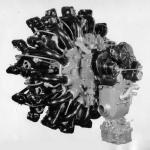 |
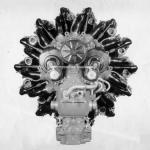 |
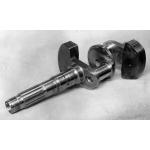 |
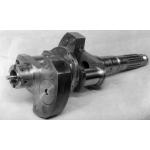 |
 |
| Twin Wasp Junior |
Twin Wasp Junior |
Twin Wasp Junior |
Crankshaft |
Crankshaft |
Dynamic Vibration Absorber |
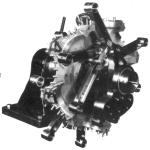 |
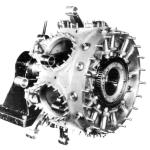 |
 |
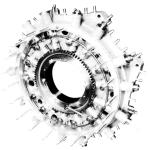 |
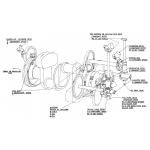 |
|
| Center Crankcase with Crankshaft |
Crankshaft Aft Section |
Front View, Blower Installed |
Crankcase Fore Section |
Gear Train |
|











